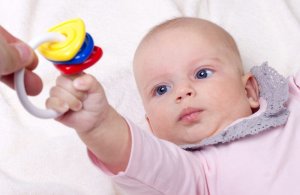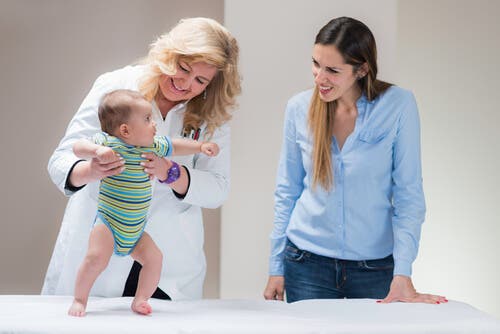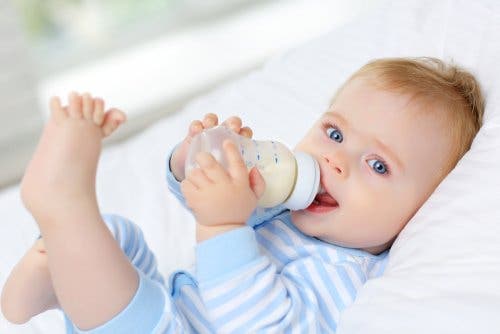Classification of Newborn Reflexes

From birth, babies begin to perform certain innate movements in order to adapt to the environment, survive, and protect themselves. They’re called newborn reflexes, which can be categorized into various types. Therefore, in this article, we’ll explain the classification of newborn reflexes.
As healthy babies grow, they develop a series of psychomotor skills. Thus, at first, the movements babies perform are the consequence of reflexive acts and aren’t intentional. But, gradually, they acquire the ability to control their bodily movements.
What are newborn reflexes?
Reflexes are organized patterns of behavior that are performed as a response or reaction to external stimuli. In this regard, these movements can occur in the following ways:
- Innate.
- Involuntary.
- Automatic.
Most reflexes disappear with age, typically in the first six months when voluntary body control increases. Nevertheless, others are maintained and perfected throughout life. Walking, as well as the parachute reflex, is a reflex that appears when babies are approximately five or six months of age.

In this sense, bear in mind that the permanence of a reflex in a baby after the age at which it must disappear can imply the existence of brain damage or nervous system problems.
Classification of newborn reflexes
As we mentioned above, there are different types of newborn reflexes. These reflexes are classified according to their time of appearance and disappearance. Thus, reflexes can:
- Appear at birth and transform into voluntary movements months later.
- Completely disappear in the first months of life.
- Disappear after a short time and reappear months later on a voluntary basis.
- Manifest around birth and never disappear.
Reflexes that appear at birth and transform into voluntary movements months later
- Rooting reflex. When you caress one of your baby’s cheeks, they move their head and orient their mouth to that side. This reflex becomes a voluntary action at three to four months.
- Sucking reflex. When you insert an object or a finger into a baby’s mouth, they begin to suck. Thus, at three or four months, this reflex becomes a voluntary movement, necessary for feeding.
Reflexes that completely disappear in the first months of life
- Palmar and plantar grasping pressure. When pressure is exerted with the finger or with an object in the palm of the hand or on the sole of the baby’s foot, they shrink their fingers and flex them downwards. This reflex disappears between three and four months.
- Moro reflex. When the baby makes a sudden change in position, they react by extending their arms, opening their hands, folding their back, and returning to the starting position. If the moor reflex doesn’t disappear after four or six months, it means that there may be central nervous system alterations.
- Babinski reflex. If the baby’s sole is stimulated, they react by flexing their thumb and spreading the rest out. This action usually disappears around eight or nine months.
- Tonic neck reflex. When the baby’s head is turned to one side, they extend their arm and leg in that direction, while flexing their limbs on the other side. This reflex disappears at approximately three or four months.

Disappear after a short time and reappear months later on a voluntary basis
- Stepping reflex. When you hold the newborn and stand upright on a straight surface, their response is to perform an automatic walking motion. This reflex disappears after two or three months but is learned voluntarily months later, when the child begins to take the first steps.
- Ascension. The baby, when faced with an obstacle, lifts their foot and flexes the knee. This reaction occurs until two or three months. Then, it’s learned as a voluntary act.
- Reflex creeping. Up to four months, babies can automatically coordinate their arms and legs to crawl. In the crawling phase, this movement reappears but is carried out consciously.
Reflexes that appear around birth and remain throughout life
- Patellar tendon reflex. Shortly after birth, if you hit a baby under the kneecap, they extend their leg forward. This is a reflex that remains throughout life.
- Cough reflex. Cough is an automatic reaction to some airway stimulus.
- Sneeze reflex. Sneezing is a reflex that manifests from the first months of life in order to expel some discomfort through the nasal passages.
From birth, babies begin to perform certain innate movements in order to adapt to the environment, survive, and protect themselves. They’re called newborn reflexes, which can be categorized into various types. Therefore, in this article, we’ll explain the classification of newborn reflexes.
As healthy babies grow, they develop a series of psychomotor skills. Thus, at first, the movements babies perform are the consequence of reflexive acts and aren’t intentional. But, gradually, they acquire the ability to control their bodily movements.
What are newborn reflexes?
Reflexes are organized patterns of behavior that are performed as a response or reaction to external stimuli. In this regard, these movements can occur in the following ways:
- Innate.
- Involuntary.
- Automatic.
Most reflexes disappear with age, typically in the first six months when voluntary body control increases. Nevertheless, others are maintained and perfected throughout life. Walking, as well as the parachute reflex, is a reflex that appears when babies are approximately five or six months of age.

In this sense, bear in mind that the permanence of a reflex in a baby after the age at which it must disappear can imply the existence of brain damage or nervous system problems.
Classification of newborn reflexes
As we mentioned above, there are different types of newborn reflexes. These reflexes are classified according to their time of appearance and disappearance. Thus, reflexes can:
- Appear at birth and transform into voluntary movements months later.
- Completely disappear in the first months of life.
- Disappear after a short time and reappear months later on a voluntary basis.
- Manifest around birth and never disappear.
Reflexes that appear at birth and transform into voluntary movements months later
- Rooting reflex. When you caress one of your baby’s cheeks, they move their head and orient their mouth to that side. This reflex becomes a voluntary action at three to four months.
- Sucking reflex. When you insert an object or a finger into a baby’s mouth, they begin to suck. Thus, at three or four months, this reflex becomes a voluntary movement, necessary for feeding.
Reflexes that completely disappear in the first months of life
- Palmar and plantar grasping pressure. When pressure is exerted with the finger or with an object in the palm of the hand or on the sole of the baby’s foot, they shrink their fingers and flex them downwards. This reflex disappears between three and four months.
- Moro reflex. When the baby makes a sudden change in position, they react by extending their arms, opening their hands, folding their back, and returning to the starting position. If the moor reflex doesn’t disappear after four or six months, it means that there may be central nervous system alterations.
- Babinski reflex. If the baby’s sole is stimulated, they react by flexing their thumb and spreading the rest out. This action usually disappears around eight or nine months.
- Tonic neck reflex. When the baby’s head is turned to one side, they extend their arm and leg in that direction, while flexing their limbs on the other side. This reflex disappears at approximately three or four months.

Disappear after a short time and reappear months later on a voluntary basis
- Stepping reflex. When you hold the newborn and stand upright on a straight surface, their response is to perform an automatic walking motion. This reflex disappears after two or three months but is learned voluntarily months later, when the child begins to take the first steps.
- Ascension. The baby, when faced with an obstacle, lifts their foot and flexes the knee. This reaction occurs until two or three months. Then, it’s learned as a voluntary act.
- Reflex creeping. Up to four months, babies can automatically coordinate their arms and legs to crawl. In the crawling phase, this movement reappears but is carried out consciously.
Reflexes that appear around birth and remain throughout life
- Patellar tendon reflex. Shortly after birth, if you hit a baby under the kneecap, they extend their leg forward. This is a reflex that remains throughout life.
- Cough reflex. Cough is an automatic reaction to some airway stimulus.
- Sneeze reflex. Sneezing is a reflex that manifests from the first months of life in order to expel some discomfort through the nasal passages.
All cited sources were thoroughly reviewed by our team to ensure their quality, reliability, currency, and validity. The bibliography of this article was considered reliable and of academic or scientific accuracy.
- Alzate-Grisales, E. (2010). Manual de estimulación adecuada. Bebés recién nacidos hasta los 2 años. Medellín: Universidad de Antioquia.
- Conde, J. L. y Viciana, V. (1997). Fundamentos para el desarrollo de la motricidad en edades tempranas. Málaga: Aljibe.
This text is provided for informational purposes only and does not replace consultation with a professional. If in doubt, consult your specialist.








